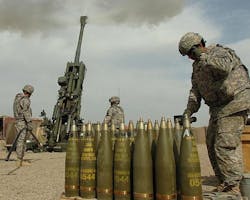Army makes big order for Excalibur satellite-guided smart munitions artillery rounds
Officials of the Army Contracting Command at Picatinny Arsenal, N.J., are asking the Raytheon Missile Systems segment in Tucson, Ariz., to produce Option 6 Excalibur 155-millimeter Increment Ib projectiles. Excalibur first was fielded in Iraq in 2007 for urban or complex-terrain engagements in which collateral damage must be kept to a minimum.
Excalibur has a ruggedized Global Positioning System (GPS) satellite navigation receiver and uses satellite signals to help guide itself to its intended targets. The 155-millimeter artillery shell can hit targets as far away as 25 miles, or detect and attack moving targets in cities and other complex terrain after being fired at high angles and high altitudes.
The M982 Excalibur precision-guided, extended-range artillery shell is a fire-and-forget smart munition with better accuracy than existing 155-millimeter artillery rounds. These shells are fin-stabilized, and are designed to glide to targets with base bleed technology, as well as with canards located at the front of the munition that create aerodynamic lift.
Although the M982 is perhaps the longest-range artillery ammunition in the U.S. arsenal, it has the ability to be fired nearly straight up from positions in cities or hilly terrain, engage its precision-guidance system at high altitudes, and detect and attack moving targets -- even individual vehicles -- with an accuracy of better than 65 feet from the desired aim point.
The shells are guided by GPS signals and inertial measurement units, and can be fired from the M109 self-propelled howitzer family, as well as from the M198 and M777A2 towed howitzers. This munition also is under consideration for naval deck guns.
Excalibur artillery shells come in three kinds: high-explosive; smart munitions that detect and attack moving targets; and shells able to identify and attack vehicles individually in cities and other complicated terrain. A new variant incorporates a laser spot tracker into the combat-Excalibur Ib projectile.
The laser spot tracker will enable the munition to attack moving targets, engage enemy artillery that have moved after firing, or change the impact point to avoid casualties and collateral damage.
Related: Army to buy 30 reconditioned and upgraded 155-millimeter self-propelled artillery pieces
The Army also is developing a GPS-guided 120-millimeter mortar round called the Roll Control Guided Mortar (RCGM) together with the General Dynamics Corp. Ordnance and Tactical Systems segment in St. Petersburg, Fla.
On this order Raytheon will do the work in Tucson, Phoenix, and Gilbert, Ariz.; McAlester, Okla.; Farmington, N.M.; East Camden, Ark.; Healdsburg, Santa Ana, Valencia, and Corona, Calif.; Cincinnati; Cedar Rapids, Iowa; Joplin, Mo.; Lansdale, Pa.; Karlskoga, Sweden; Southway, England; Glenrothes, Scotland; Salt Lake City; Minneapolis; Woodridge, Ill.; and Congers, N.Y., and should be finished by January 2020.
For more information contact Raytheon Missiles Systems online at www.raytheon.com, or the Army Contracting Command-New Jersey at www.slideshare.net/ArmyContracting/nj-22934540.
Ready to make a purchase? Search the Military & Aerospace Electronics Buyer's Guide for companies, new products, press releases, and videos
